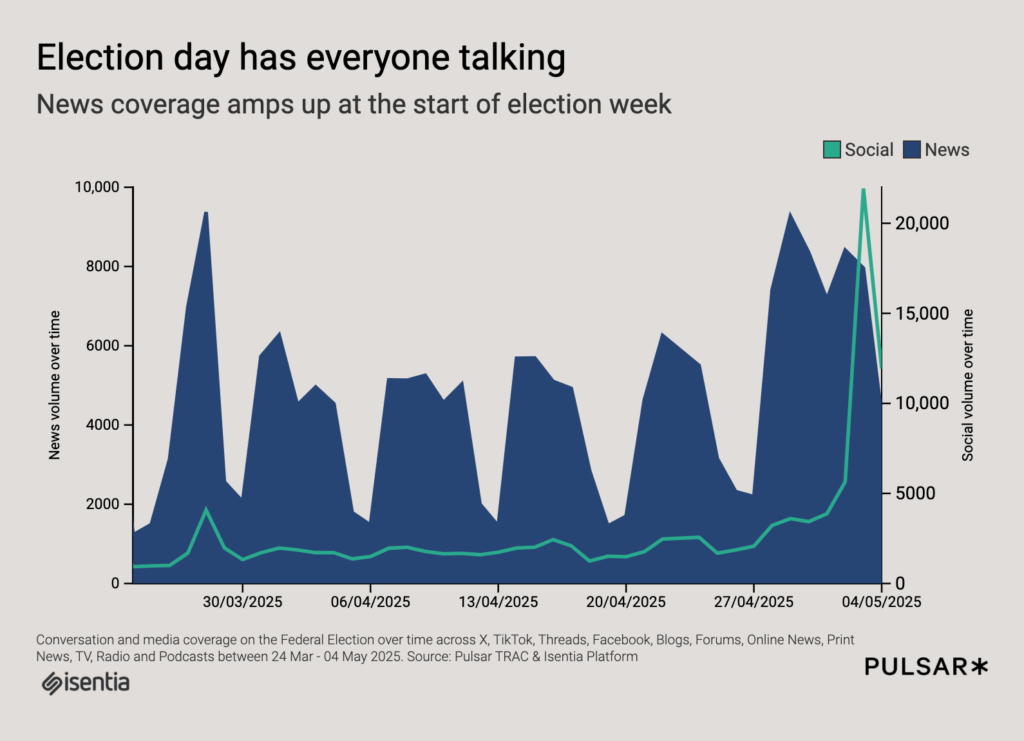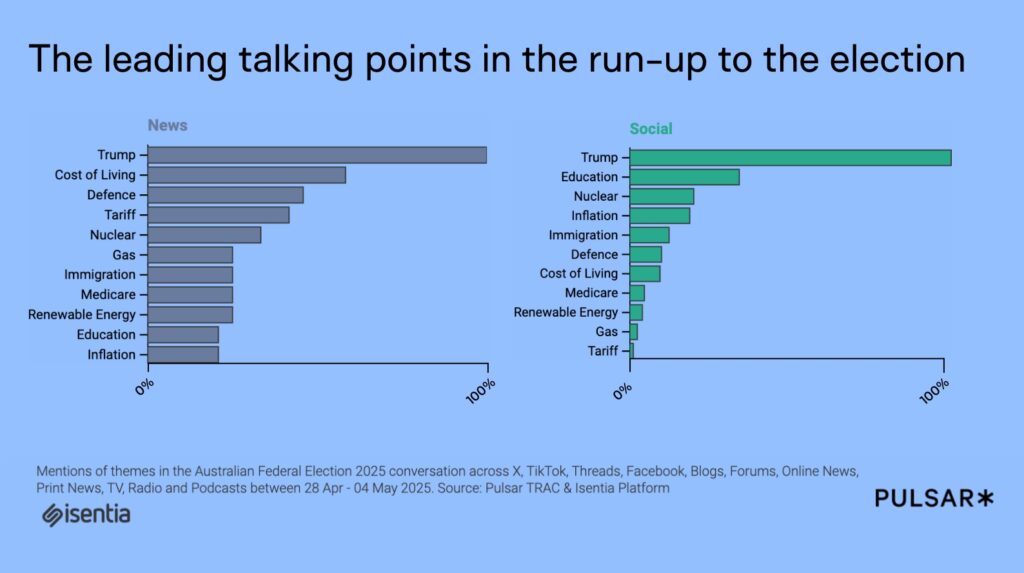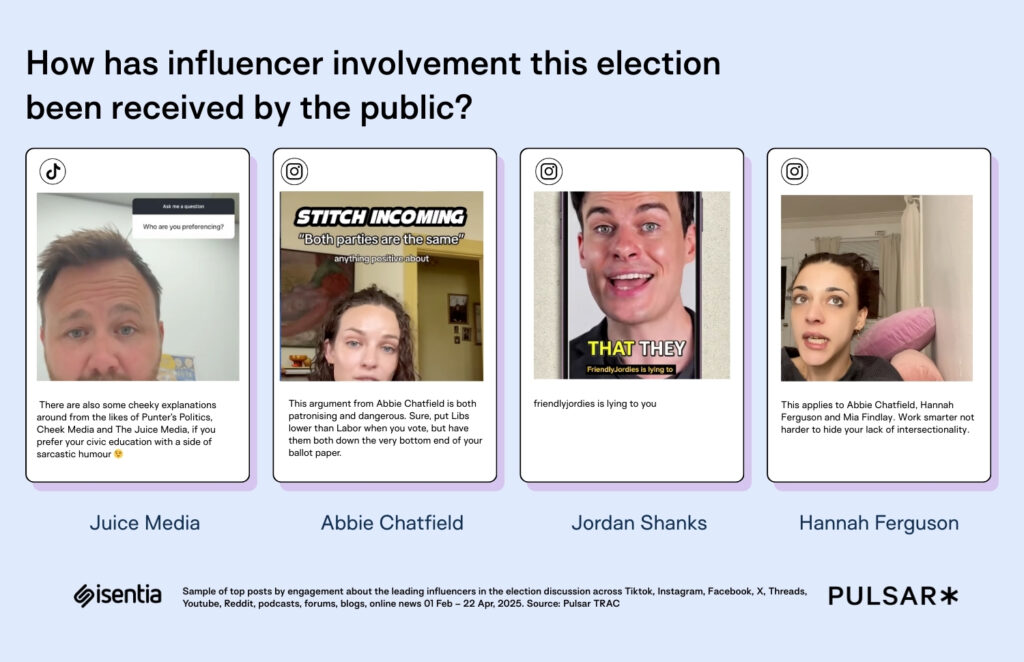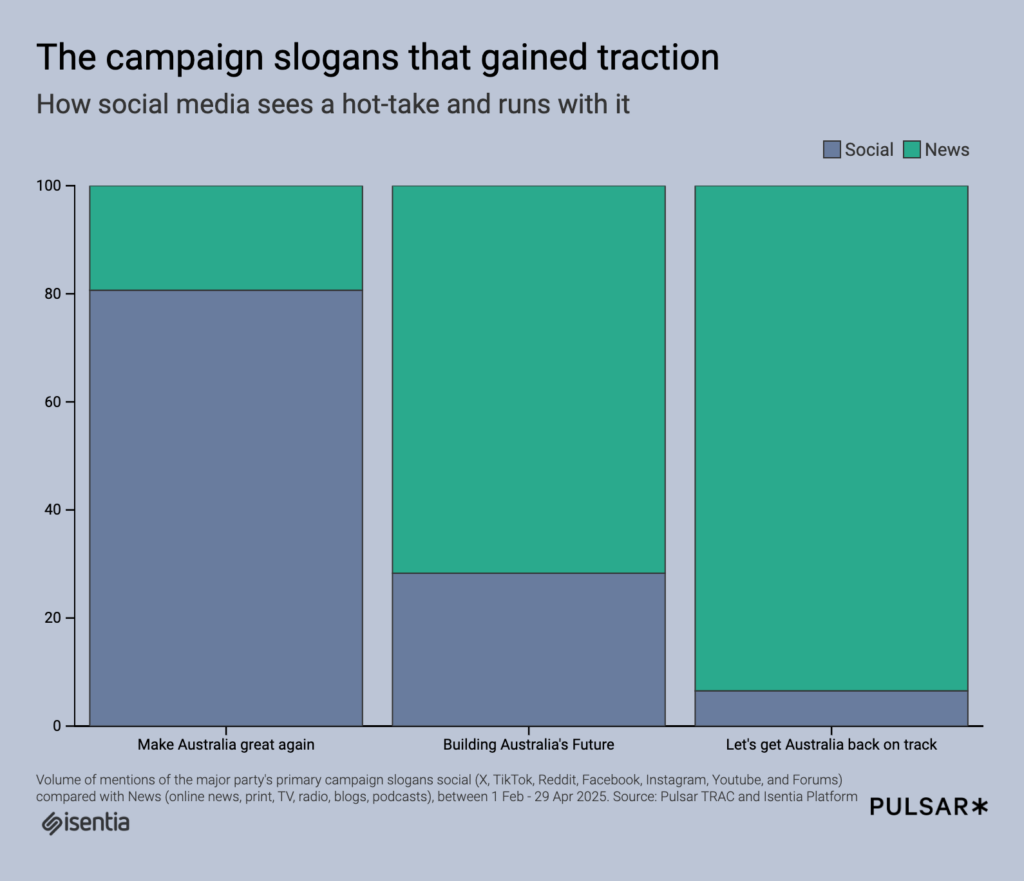Media and social highlights from the election campaign 2025
This was not an election won or lost on policy alone. While political parties released detailed plans around cost-of-living relief, energy, healthcare and education, the battle for attention played out across a different terrain. One shaped by identity, digital influencers and polarised media narratives. 1. Policy set the agenda, but didn’t hold it At the […] The post Media and social highlights from the election campaign 2025 appeared first on Isentia.

This was not an election won or lost on policy alone. While political parties released detailed plans around cost-of-living relief, energy, healthcare and education, the battle for attention played out across a different terrain. One shaped by identity, digital influencers and polarised media narratives.

1. Policy set the agenda, but didn’t hold it
At the start of the campaign, traditional media focused on familiar priorities. The Labor government’s May budget led with cost-of-living relief, fuel excise changes and increased rental support. The Liberals responded with proposals for nuclear energy and a plan to cut 40,000 public service jobs. While these issues framed the early weeks, they were quickly overtaken in online discussions by stories with more cultural weight.
On social media, a video comparing Peter Dutton to Donald Trump circulated widely, while Anthony Albanese’s “delulu with no solulu” moment during a Happy Hour podcast interview was picked up by national outlets and widely shared on social platforms. Personality often generated more interest than policy.

2. Messaging strategy went beyond the platforms
Both major parties tried to engage younger voters where they spend their time. Albanese’s appearance on podcasts and his interviews with influencers like Abbie Chatfield reflected a values-driven approach. Dutton’s appearance on Sam Fricker’s podcast targeted young men through a more casual, conversational format.
Mainstream media covered these appearances but often through the lens of political tactics rather than substance. When Abbie Chatfield’s pro-Greens posts attracted AEC scrutiny in early April, the story became more about influencer regulation than her political message.

3. Polarisation dominated public debate
The second leaders’ debate on 10 April marked a turning point, with stark contrasts on energy, education and immigration. Dutton’s focus on crime and border control drew backlash, while Albanese was seen as calm but cautious. Instead of clarifying party differences, the debate intensified existing divides.
Online commentary quickly split along ideological lines. Audiences did not just debate the leaders’ points but used the debate to reinforce partisan views, highlighting how polarised public discourse has become.
4. Influencers reshaped election storytelling
Influencers became central to election storytelling. Abbie Chatfield faced strong support and criticism after posting about the Greens and questioning the Liberal Party’s media strategy. The Juice Media released satirical videos targeting defence and energy policies, resonating with disillusioned younger audiences.
Even incidents unrelated to official campaigns became flashpoints. In February, a video from an Israeli influencer alleging antisemitic comments by NSW nurses went viral, triggering political statements and shifting media attention to broader issues of hate speech and accountability online.

5. Culture wars outpaced policy in the final stretch
As the election neared, cultural tensions gained traction. On 12 April, media attention turned to Peter Dutton after reports emerged that his Labor opponent Ali France was leading in Dickson. Around the same time local authorities dismantled a tent encampment in the area while Dutton was campaigning in Perth. This raised questions about leadership and visibility on local issues.
Across social and news media, themes like Gaza, curriculum debates and identity politics took centre stage. Slogans such as “Get Australia back on track” were interpreted as echoes of US political rhetoric. Jacinta Price and Clive Palmer were both linked to similar messaging, fuelling memes and commentary about the Americanisation of Australian politics.
Rather than rallying around shared policy concerns, audiences engaged with content that reflected deeper anxieties about national identity and international influence.

What stood out the most wasn’t necessarily the policy itself, but the moments, memes, and messages that tapped into cultural tensions. The freedom for media and social media users to connect with and amplify these narratives created an arena where some politicians struggled to engage effectively. While some stuck to party lines without fully understanding the patterns driving media and social discourse, others embraced the shift, adapting to the rhetoric that was emerging online. The lesson is clear: in today’s media environment, ignoring what people are saying or the patterns of conversation isn’t an option.
Discover more of our political news services
The post Media and social highlights from the election campaign 2025 appeared first on Isentia.











































































































































































![[The AI Show Episode 156]: AI Answers - Data Privacy, AI Roadmaps, Regulated Industries, Selling AI to the C-Suite & Change Management](https://www.marketingaiinstitute.com/hubfs/ep%20156%20cover.png)
![[The AI Show Episode 155]: The New Jobs AI Will Create, Amazon CEO: AI Will Cut Jobs, Your Brain on ChatGPT, Possible OpenAI-Microsoft Breakup & Veo 3 IP Issues](https://www.marketingaiinstitute.com/hubfs/ep%20155%20cover.png)




































































































































































































































































_incamerastock_Alamy.jpg?width=1280&auto=webp&quality=80&disable=upscale#)
_Brain_light_Alamy.jpg?width=1280&auto=webp&quality=80&disable=upscale#)



























































































![Nothing Phone (3) has a 50MP ‘periscope’ telephoto lens – here are the first samples [Gallery]](https://i0.wp.com/9to5google.com/wp-content/uploads/sites/4/2025/06/nothing-phone-3-telephoto.jpg?resize=1200%2C628&quality=82&strip=all&ssl=1)


























































































